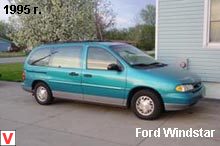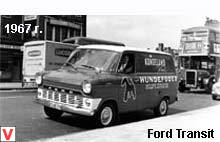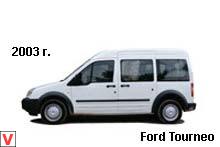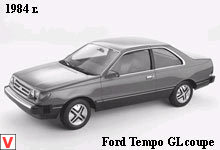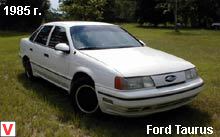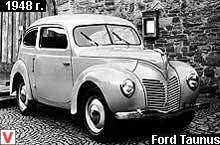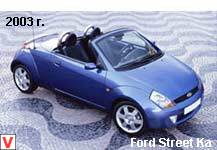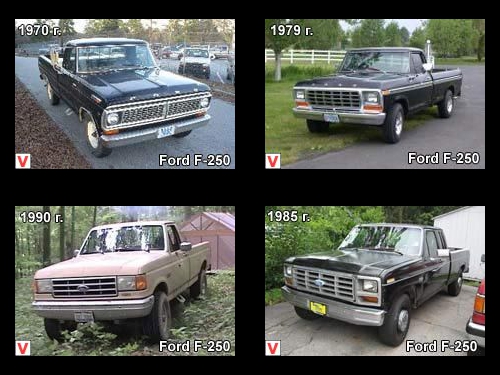
In general, the F-series is a series of full-size pickups from Ford sold for 60 years. Model F-250 first appeared in 1953, which replaced the model of the first generation of pickups called F-2. The names of pickups received in accordance with their capacity. Consequently, the F-250 was the second pick-up in the ascending capacity, its figure was 750 kg, and the maximum weight allowed was 3,360 kg. March 13, 1953 as an option, the car begins to equip the Ford-O-Matic automatic gearbox.
Initially, only two versions of gasoline engines were offered for pickups: Flathead V8 with a volume of 3.9 liters and 100 hp. and a 6-cylinder Straight-6 with a volume of 3.5 liters, whose power was 101 hp. In 1954, two more power units appeared in the list of engines, namely: the 6-cylinder “Mileage Maker” straight-6 with a volume of 3.7 liters and 115 hp. and the Y-block “Power King” V8 with a volume of 3.9 liters and a power of 130 hp.
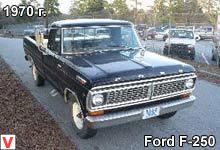
In the same year, the car received power steering, which allowed to increase the car’s handling by 50%. In 1956, the power of the “Maker” straight-6 with a volume of 3.7 liters increases to 137 hp, and the Y-block “Power King” V8 with a volume of 3.9 liters changes the 4.5-liter power unit of the Y-block V8 with a capacity of 173 hp. . In 1957, the third generation of the F-Series pickups arrived. The cars received a new hood and a chrome grille, the other parts of the body also underwent changes.
In May 1957, the production of heavy trucks, previously carried out at the Highland Park Ford plant in Highland Park (Michigan), was moved to the Kentucky Truck Assembly assembly plant in Louisville (Kentucky), and the production of light and medium trucks was distributed among ten other plants in the United States. In 1959, a system of all-wheel drive, which was previously used by the company Marmon-Herrington (the company for the production of trucks, buses and trolley buses), appears, and this was famous for at that time.

The list of engines offered for the third generation included the following power units: the 6-cylinder “Mileage Maker” straight-6 with a volume of 3.7 liters and 137 hp; a 4.5-liter Y-block V8 with a capacity of 173 hp. and Y-block V8 with a volume of 4.8 liters, whose power was 186 hp (since 1959). In 1961, the fourth generation of pickups was marked by complete body recycling.
Now the supporting structure included the front (cabin) and rear. In general, the pickup began to look wider. This year, two engine options were proposed: the 6-cylinder “Mileage Maker” straight-6 with a volume of 3.7 liters and 137 hp. In 1965, the Twin I-Beam front suspension was introduced with cylindrical springs.

From 1965 to 1966 on the front of the truck was the TWIN I-BEAM logo. Also in 1965, a 4-door version of the cab was introduced, which still remains popular. The two previously proposed engine variants changed three new power units: 6-cylinder straight-6 with a volume of 3.9 liters and 150 hp., 6-cylinder straight-6 with a volume of 4.9 liters and 170 hp. and a 208-horsepower FE 5.8 liter FE V8 engine. In 1965, a special package of options for F- series pickups called the “Ranger” appeared. Later in 1981, the name "Ranger" will be used by Ford for a separate branch of production trucks. The next update pickups F-series was produced in 1967. This was the third generation of F-Series pickups.
This year, the Ranger option package is offered for the basic configuration, as well as various options for bundling (Custom Cab) pickups. Engines in 1967 were borrowed from the fourth generation. In 1968, new federal regulations demanded that automakers equip them with side reflectors or lights.
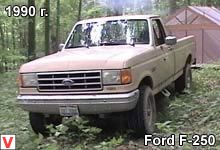
In this regard, the company Ford replaced the emblems, which were located on the hood, dimensional reflectors, and on the front now flaunted the inscription «FORD». In the same year, the 6-cylinder straight-6 with a volume of 3.9 liters and 150 hp is eliminated from the list of proposed engines and a 6-cylinder straight-6 with a volume of 4.9 liters and a power of 170 hp. And the list is complemented by two new power units: FE V8 with a volume of 5.9 liters and a power of 215 hp and FE V8 with a volume of 6.4 liters capacity of 270-335 hp. In 1969, another power unit appeared - the Windsor V8 with a volume of 5.0 liters and a power of 220 hp.
In 1970, the top-end equipment was called the Ranger XLT, and variants were offered under the names Ranger, Sport Custom and Custom. The fifth-generation bodies were noted for their simplicity, which greatly simplified their repair. In this generation F-250, the allowed maximum weight of the car was 3,405 kg, and its load capacity still remained unchanged (750 kg). In 1973 comes the sixth generation of pickups. Appearance has once again been updated. Cars got a new grille and slightly modified body panels. In 1976, some changes were also made in the area of the grille. In 1979, the round headlights were replaced by square with a kind of frame, which could be chrome or black.
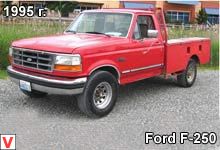
In this generation, a new system for the identification of all-wheel drive versions of their VIN number and identification plate. It consisted in the following, if the number began with the F10, then this meant that it was the F-100 model with 2-wheel drive, and now F11 - F100 with all-wheel drive. For example, the F-250 model with 2-wheel drive is the F25, and the all-wheel drive is already the F26. Also, the model F-250 had several different modifications. With 2 wheel drive: F250 F251 F252 F253 F254 F255 F256 F257 F258 F259 F259 with a maximum weight of 2815-3677 kg.
And all-wheel drive versions: F260 F261 F262 F263 F264 F265 F266 with a maximum weight allowed 2950-3814 kg. In 1973, the following engine options were proposed: 6-cylinder straight-6 with a volume of 3.9 liters and 150 hp; 6-cylinder straight-6 with a volume of 4.9 liters and 101 hp; FE V8 volume of 5.8 liters capacity of 208 hp; FE V8 with a volume of 5.9 liters and 145 hp (used until 1976); FE V8 volume of 6.4 liters capacity of 270-335 hp, Windsor V8 volume of 5.0 with a capacity of 130 hp; 385 V8 with a volume of 7.5 liters and a power of 200-275 hp (the engine was not available for all-wheel drive versions).
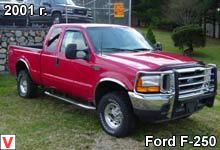
In 1977, there were only three options on the list of proposed engines: 385 V8 with a volume of 7.5 liters and 200-275 hp; 385 V8 with a volume of 5.8 liters capacity of 150-163 hp; 385 V8 volume of 6.6 liters capacity of 169 hp And in 1978, the 6-cylinder straight-6 with a volume of 4.9 liters and 114 hp appeared in the list. In 1980, the F-series including the F-250 undergoes another major redesign. The updated pickups had a more “square” appearance, with sharp lines and flat body panels. The name “Ranger” for the package of options was removed, and instead there were new designations of complete sets, such as XL, XLS, XLT and XLT Lariat.
For this generation of pickups, the following engines were proposed: Windsor V8 4.2-liter (used until 1981); 6-cylinder straight-6 with a volume of 4.9 liters; Windsor V8 with a volume of 5.0 liters (used until 1985, in 1985 it was replaced by the V8 Windsor FI with a volume of 5.0 liters and an output of 185 hp); Ford 335 V8 with a volume of 5.8 liters (used until 1982); 335 series V8 with a volume of 6.6 liters. In 1982, the Essex V6 engine was offered with a volume of 3.8 liters, which was used until 1983. 1983 was marked by the appearance in the list of the proposed engines of the diesel power unit Navistar Diesel V8 with a volume of 6.9 liters and a power of 170 hp.

Also this year, two more petrol engines appeared on the list: the V8 Windsor with a volume of 7.5 liters and whose power was 245 hp. In 1987, the eighth generation of the F-250 was launched, as well as the entire F-series. The design of cars was simplified, which made them more convenient to maintain.
Anti-lock braking system on the rear brakes was standard, and was first used in pickups. In 1988, cars received a new 5-speed manual transmission. For 1987 and 1988 The equipment of engines of 4.9, 5.8 and 7.5 liters with fuel injectors is typical. 1988 was the first year for the F-series, when not a single carburetor engine was proposed. Also this year, a 6.9-liter diesel engine was replaced by a International Harvester IDI V8 7.3-liter diesel power unit with a capacity of 180 hp.
For 1988, the list of proposed engines included: 6-cylinder straight-6 EFI with a volume of 4.9 liters and 150 hp; Windsor V8 EFI volume of 5.0 liters capacity of 185 hp.; Windsor V8 EFI volume of 5.8 liters capacity of 210 hp.; 460 V8 EFI volume of 7.5 liters capacity of 230 hp.; International Harvester IDI V8 of 7.3 liters capacity of 180 hp .. In 1992, there is the ninth generation of pickups. F-Series models get an updated front end with higher aerodynamics and a new dashboard. Also cars were equipped with 17-inch rims and gas shock absorbers. In 1994, a CD changer appears on the equipment list, and the driver’s airbag is installed.
The permitted maximum mass of the model F-250 is 2,996 kg. In the same year, for the F-series, the first turbocharged power unit Power Stroke turbo-Diesel V8 of 7.3 liters capacity of 210 hp is offered. In 1997, the tenth generation F-250 appears. The basic version of the car (light duty) as a whole was an F-150 model, but it had a reinforced suspension and a transverse beam of the bridge. The F-250 HD (Heavy Duty) was a model of the F-350, but with a lower payload (750 kg, while the F-350 has 1,000 kg). Also for cars offered a wide selection of bodies. As for the drive, it was offered front-wheel drive and all-wheel drive versions.
At the end of the 90s, the following engines were offered for pickups: Essex V6 with a volume of 4.2 liters and a capacity of 202 hp; Triton V8 volume of 4.6 liters capacity of 220 hp (until 1998, since 1999, its power was 231 hp); Triton V8 volume of 5.4 liters capacity of 235 hp (until 1998, from 1999 - 260 hp); turbocharged supercharged Triton V8 with a volume of 5.4 liters (power up to 2000 - 360 hp, after 2000 380 hp). In 2004, the eleventh generation of the F-250 comes out, which is still available today. Pickup acquired a formidable sleek exterior, with a massive grille and bumper. The cars were based on the P2 platform developed by Ford.
Models F-250 and A-350 in a separate line of commercial pickups with high payload Ford Super Duty, the maximum weight of which was more than 3 860 kg. For 2007, the list of proposed engines for the eleventh generation includes: Triton V8 4.6-liter, 3V Triton V8 5.4-liter and Essex V6 4.2-liter. As for the transmission, the 5-speed manual gearbox is only available for the V6 engine, and a 4-speed automatic transmission is available as an option for the V6 engine, and was standard for the V8 engines. Also in the same year, the company introduced two packages of options: FX4 for all-wheel drive versions and FX2 Sport for front-wheel drive pickups.
The options package includes the following improvements: more reliable shock absorbers, special protective plates for the fuel tank, 18-inch rims, tires with high tread.
